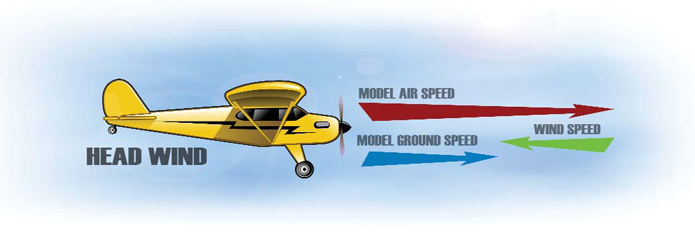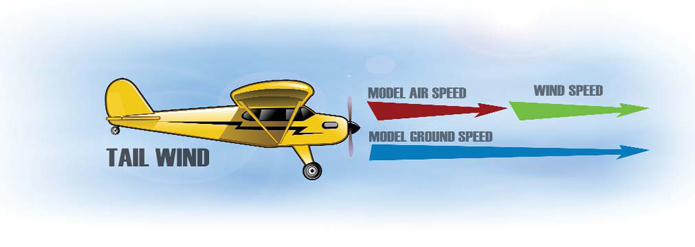Let’s see a show of hands here. How many of you have become amateur meteorologists since you learned to fly model airplanes? Yeah; me too. It seems as if I always have my eye on the treetops looking for calm conditions that will allow me a quick flight here or there. I’ve gone as far as programming several weather websites into my cell phone for a quicker reference! It’s amazing just how much even light breezes affect the smaller and lighter models we commonly use for RC flight training. This month, I focus on understanding the effects of wind on our models, and I suggest techniques to handle breezes.
ESTIMATING WIND SPEED
We’ve all heard the local RC expert claiming he flew his stock Slow Stick in 20mph wind that gusted to 30. Well, unless he checked it with an anemometer, don‘t believe him. Just how strong is a 30mph wind? Well, it‘s strong enough to raise all our eyebrows on the flight line, even when I‘m flying my 130,000- pound Boeing jet. I think that most modelers dramatically overestimate wind speed, not so much in an attempt to impress, but more because they lack perspective.
This lack of perspective isn‘t surprising because U.S. weather observations give wind speed in knots and miles per hour, and it isn’t easy to wrap our heads around those numbers. A wind of 39 to 54mph is a “gale,†12.65 to 18.4mph is a “moderate breeze,†and 8 to 11.5mph is a “gentle breeze.†The upper limit of a “breeze†is 31mph. Any higher, and we‘re flying in wind!
To help us estimate wind speed, let‘s use simple math to convert miles per hour (mph) into feet per second (fps)‘a unit we can more easily “see†and estimate.
| ACTUAL | ROUNED UP | |
| MPH | FPS | FPS |
| 5 | 7.33 | 7.5 |
| 10 | 14.67 | 15 |
| 15 | 22 | 22 |
| 20 | 29.33 | 30 |
| 25 | 36.67 | 37 |
| 30 | 44 | 44 |
The numbers in this simple table will make it a lot easier for you to estimate wind speed. You can decide for yourself whether the degree of error caused by rounding off the actual fps number to the nearest 1/2 (.5) is important to you.
Most fields have dandelions, grass clippings and other things that the wind easily blows around. Toss a dried dandelion seed into the air and estimate the distance it travels in a second. To actually have a 30mph wind, your dandelion seed would have to travel 45 feet in one second—pretty strong wind, eh? I’ll guess that the Slow Stick pilot really wasn‘t flying in a 30mph wind. Another reference point is a windsock: RC and full-scale windsocks will be fully extended at 20 to 25mph and half extended with the breeze at around 10mph. Most light models can safely be flown in a 5 to 7mph breeze, but when it’s stronger than that, flying is a lot less fun and a lot more work. Larger, heavier models handle the wind better, but most of us put our models away when the wind speed reaches 20mph.
AIRSPEED & GROUNDSPEED
Let’s define a couple of terms to kick off this discussion. For starters, airspeed and groundspeed are not the same. Imagine yourself in a Piper Cub flying along with 75mph showing on the airspeed indicator. Flying in still air, the airspeed matches the groundspeed—75 mph (for the engineers in the crowd, let‘s assume that indicated and true airspeed are the same). When flying into a 20mph headwind, the airspeed may be 75mph, but the groundspeed is only 55mph (75-20 = 55). Conversely, with a 20mph tailwind, your groundspeed will increase to 95mph (75+20 = 95). In short, flying at a constant airspeed, the groundspeed will depend on the aircraft’s course relative to the prevailing wind. As you can imagine from these numbers, it isn‘t at all unusual for a Cub to be outrun by traffic on the highway.

The speed of any aircraft over the ground is a function of both its
airspeed, and any local winds that may be blowing. In calm air,
the airplane’s ground speed equals the airspeed. When flying into
a headwind, the ground speed is the difference between the airspeed
and wind speed. When flying with a tailwind, the ground
speed is the sum of the airspeed and wind speed.

Now for the rub; when you fly your model, what do you look at to judge its speed? Do you have an airspeed indicator that tells you its airspeed? Of course not. If you‘re like most modelers, you judge the model‘s speed by comparing its movement in relation to yourself as you stand on the ground. Effectively, you‘re judging its groundspeed. This can be problematic because your model‘s aerodynamic performance is determined by its airspeed—not groundspeed. Many pilots try to adjust the model’s airspeed to maintain a constant groundspeed. While flying into the wind, they generally add throttle and fly the model faster (airspeed) to maintain a constant groundspeed. Conversely, while flying downwind, they fly the model more slowly to compensate for the higher groundspeed because of the tailwind. This technique can cause problems in stronger winds because the model will fly only so slowly before it reaches the stalling angle of attack and clearly loses control authority at the slower airspeed. A better technique is to maintain a safe flying airspeed based on pitch and power settings and simply accept the resultant groundspeed changes.
CONCLUSION
So what‘s this month‘s lesson? Be careful to keep the speed up when flying in a tailwind because your natural tendency will be to reduce the throttle and fly too slowly in an attempt to match the downwind groundspeed to the calm or upwind groundspeed. Be aware of the wind speed and direction, and also know the usual throttle and elevator settings for your particular model at different airspeeds. Resist the urge to fly the model too slowly with a tailwind.
The most critical time to be aware of wind direction and velocity is on takeoff and landing. As a rule, you want to take off and land directly into the wind. Applying what we’ve learned about groundspeed and airspeed, this allows a slower groundspeed for both maneuvers. Taking off and landing into the wind also ensures control authority throughout the takeoff or landing roll.
Flying your RC airplane in wind can be challenging. It can also be a very rewarding validation of your newly developed flying skills. While it is good to be cautious, it is also good to expand your horizons and flying opportunities by flying when conditions aren‘t perfect. Your new confidence when controlling your model will undoubtedly spill over into all aspects of your RC experience. Till next time: remember that learning is fun!
 Fly RC Magazine WE LIVE RC
Fly RC Magazine WE LIVE RC
